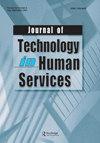Empirical insights on technology use for navigating human services
IF 1.5
Q2 SOCIAL WORK
引用次数: 5
Abstract
Abstract A considerable portion of the US population still lacks access to technology, which causes challenges for marginalized communities to access information and services. Research on the digital divide exists in various contexts, but few have examined it in the context of human services. This study examines the impact of socioeconomic status on the methods of communication used when searching for service-related information. We analyzed both quantitative and qualitative data collected from 63 low-income and/or current human service users in Albany, New York. Education showed positive associations with smartphone ownership and personal computer use. Income was found only significant for tablet use. Non-whites were more likely to use mobile apps to web browsers compared to whites. Qualitative analysis revealed three key themes (i.e., availability, ease of use, and usefulness) as influencers of individual preference of methods. Our findings suggest that the digital divide is not merely about the income level but also educational background and culture. Human service professionals need to consider multiple channels to reach targeted populations for service delivery. Particularly, the collaboration between service providers and public libraries is worth examining to ensure the physical access and skills training for those who experience the digital divide at multiple levels.技术用于人类服务导航的实证见解
美国仍有相当一部分人口无法获得技术,这给边缘化社区获取信息和服务带来了挑战。关于数字鸿沟的研究存在于各种背景下,但很少有人在人类服务的背景下进行研究。本研究探讨社会经济地位对搜寻服务相关资讯时所使用的沟通方式的影响。我们分析了从纽约州奥尔巴尼的63名低收入和/或目前的人类服务使用者中收集的定量和定性数据。教育程度与智能手机拥有量和个人电脑使用呈正相关。收入只对平板电脑的使用有影响。与白人相比,非白人更有可能使用移动应用程序来浏览网页。定性分析揭示了三个关键主题(即,可用性,易用性和有用性)作为影响个人偏好的方法。我们的研究结果表明,数字鸿沟不仅与收入水平有关,还与教育背景和文化有关。人力服务专业人员需要考虑多种渠道,以达到目标人群的服务交付。特别是,服务提供商和公共图书馆之间的合作值得研究,以确保在多个层面上经历数字鸿沟的人能够获得实际访问和技能培训。
本文章由计算机程序翻译,如有差异,请以英文原文为准。
求助全文
约1分钟内获得全文
求助全文
来源期刊

JOURNAL OF TECHNOLOGY IN HUMAN SERVICES
SOCIAL WORK-
CiteScore
4.20
自引率
6.70%
发文量
6
期刊介绍:
This peer-reviewed, refereed journal explores the potentials of computer and telecommunications technologies in mental health, developmental disability, welfare, addictions, education, and other human services. The Journal of Technology in Human Services covers the full range of technological applications, including direct service techniques. It not only provides the necessary historical perspectives on the use of computers in the human service field, but it also presents articles that will improve your technology literacy and keep you abreast of state-of-the-art developments.
 求助内容:
求助内容: 应助结果提醒方式:
应助结果提醒方式:


